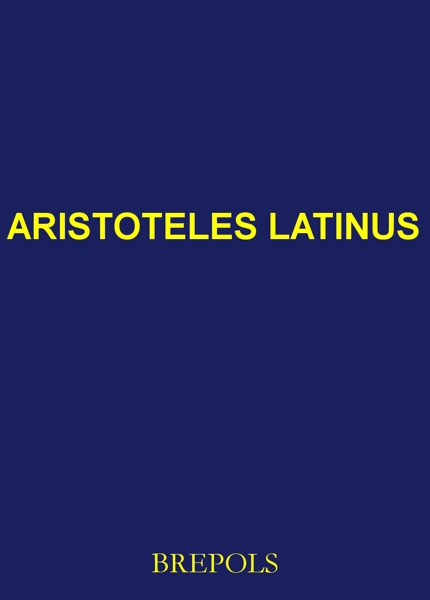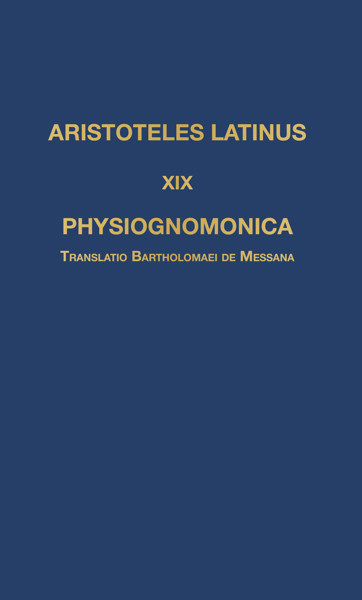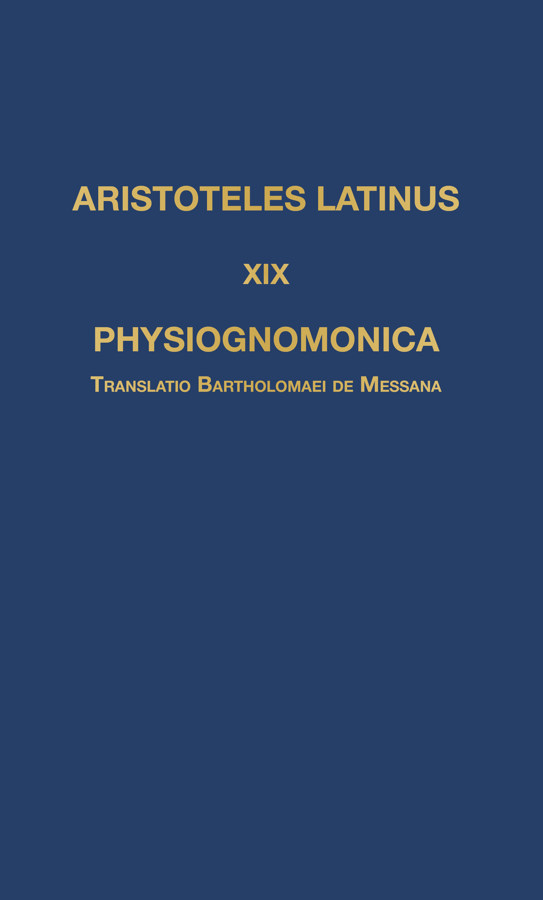
- Pages: cx + 74 p.
- Size:178 x 254 mm
- Illustrations:2 b/w, 22 tables b/w.
- Language(s):Latin, English
- Publication Year:2019
- € 90,00 EXCL. VAT RETAIL PRICE
- ISBN: 978-2-503-58567-3
- Hardback
- Available
This volume offers the first critical edition of the medieval Latin translation of pseudo-Aristotle’s Physiognomonica. The text was translated from Greek into Latin by Bartholomew of Messina during the reign of king Manfred (1258-1266) and deals with physiognomy.
“Rispetto all’unica edizione sinora esistente (...) l’edizione critica di Devriese compie un rimarchevole salto di qualità (...).
(...) la collazione di questo complesso, insieme all’individuazione dell’ottimo codice Antoniano e alla disponibilità del testo greco dal quale Bartolomeo tradusse in modo molto letterale, consentono senz’altro di costituire un testo critico di prim’ordine. In più, emergono dalle analasi svolte da Devriese nell’introduzione una serie di preziosi dettagli sulla pratica traduttoria di Bartolomeo, fra i quali una serie di doppie lezioni riconducibili all’originale et la possibilità di congetture migliorative del testo greco. (...)
Merito non secondario di questa bella edizione è anche mostrare in concreto quanto la tradizione aristotelica nel medioevo e nel Rinascimento sia stata complessa e multiforme.” (Loris Sturlese, in: Giornale critico della filosofia italiana, 16/2, 2020, 403-404)
“Le travail a été entrepris sous la direction du regretté Pieter De Leemans : nous croyons que l’édition de Lisa Devriese honore la mémoire de ce savant et poursuit idéalement la rigueur de ses recherches.” (Iacopo Costa, in: Revue des Sciences philosophiques et théologiques, 104, 2020, 167-170)
“The edition is supported not only by the usual Greek-Latin and Latin-Greek indices, but also by a double apparatus. Alongside the textual variants, indeed, Devriese presents an apparatus in which she compares the Latin text to the Greek model. (...) The result is a precious critical edition, which continues the enterprise of the Aristoteles Latinus and achieves the double result of making available to scholars a Pseudo-Aristotelian text that was among the most widespread in the Late Medieval universities, and of extending knowledge about Bartholomew of Messina’s contribution to the process of philosophical acculturation of Latin Europe.” (Riccardo Saccenti, in: Bryn Mawr Classical Review, 2021.01.27)
Lisa Devriese is assistant professor at the De Wulf-Mansion Centre for Ancient, Medieval and Renaissance Philosophy of KU Leuven (Belgium) and director of the Aristoteles Latinus edition project. In 2018, she obtained her doctoral degree with a dissertation on the reception history of pseudo-Aristotle’s Physiognomonica in the Middle Ages. She is currently working on a critical edition of the medieval Latin translation of pseudo-Aristotle’s De coloribus.
The volume offers the first critical edition of the medieval Latin translation of Aristotle’s Physiognomonica. This treatise, nowadays considered pseudo-Aristotelian, is translated into Latin between 1258 and 1266 by Bartholomew of Messina and deals with physiognomy, a discipline which connects outward appearance and inward character traits. The translation received wide circulation at the University of Paris by means of several exemplaria. The Physiognomonica has survived in 128 manuscripts, which makes it Bartholomew’s most diffused translation.
The introduction of the volume first discusses the text and manuscript tradition and then the relation to the Greek model. It appears that the Latin translation contains a unique version of the text compared to the extant Greek manuscripts, which makes it an important witness for the Greek tradition as well.
PREFACE
INTRODUCTION
I. Bartholomew of Messina’s translation of the Physiognomonica
II. The Greek Physiognomonica: author, discipline and content
III. The Physiognomonica in the Middle Ages
CHAPTER 1: THE LATIN TRADITION
I. Conspectus codicum
II. The Parisian tradition
1. The system of exemplar and pecia
2. Pecia tradition for Moerbeke’s translations
3. Pecia tradition for Bartholomew’s translations
III. The pecia tradition for the Physiognomonica
1. Taxation list of 1275 as proof for the first exemplar (P1)
2. Taxation list of 1304 as proof for the second exemplar (P2)
2.1 P2a
2.2 P2b
2.3 P2c
3. The third exemplar (P3)
4. A fourth exemplar (P4)?
5. Corrections
IV. The Italian independent tradition
V. Double readings
VI. Stemma codicum
CHAPTER 2: BARTHOLOMEW OF MESSINA’S TRANSLATION AND THE GREEK TRADITION
I. Modern studies and editions of the Greek text
II. In search of the Greek source manuscript
III. Evaluation of FÖRSTER’s Greek edition
IV. Verbum de verbo translation method
1. Grammar
1.1 Word order
1.2 Concordances
1.3 Degrees of comparison
1.4 Verbs
1.5 Particles, adverbs and conjunctions
2. Vocabulary
2.1 In search for the right terminology
2.2 Translation errors
CHAPTER 3: EDITORIAL PRINCIPLES
I. The text and Latin apparatus
1. The choice of manuscripts
2. Constitution of the text
3. The Latin critical apparatus
4. Orthography
5. Chapter division and punctuation
II. The Greek-Latin comparative apparatus
III. The Index verborum
BIBLIOGRAPHY
PHYSIOGNOMONICA. TRANSLATIO BARTHOLOMAEI
INDICES
1. Index codicum manu scriptorium
1.1 Codices Latini
1.2 Codices Graeci
2. Index nominum
2.1 Ante 1600
2.2 Post 1600
3. Index verborum
3.1 Index graeco-latinus
3.2 Index latino-graecus




